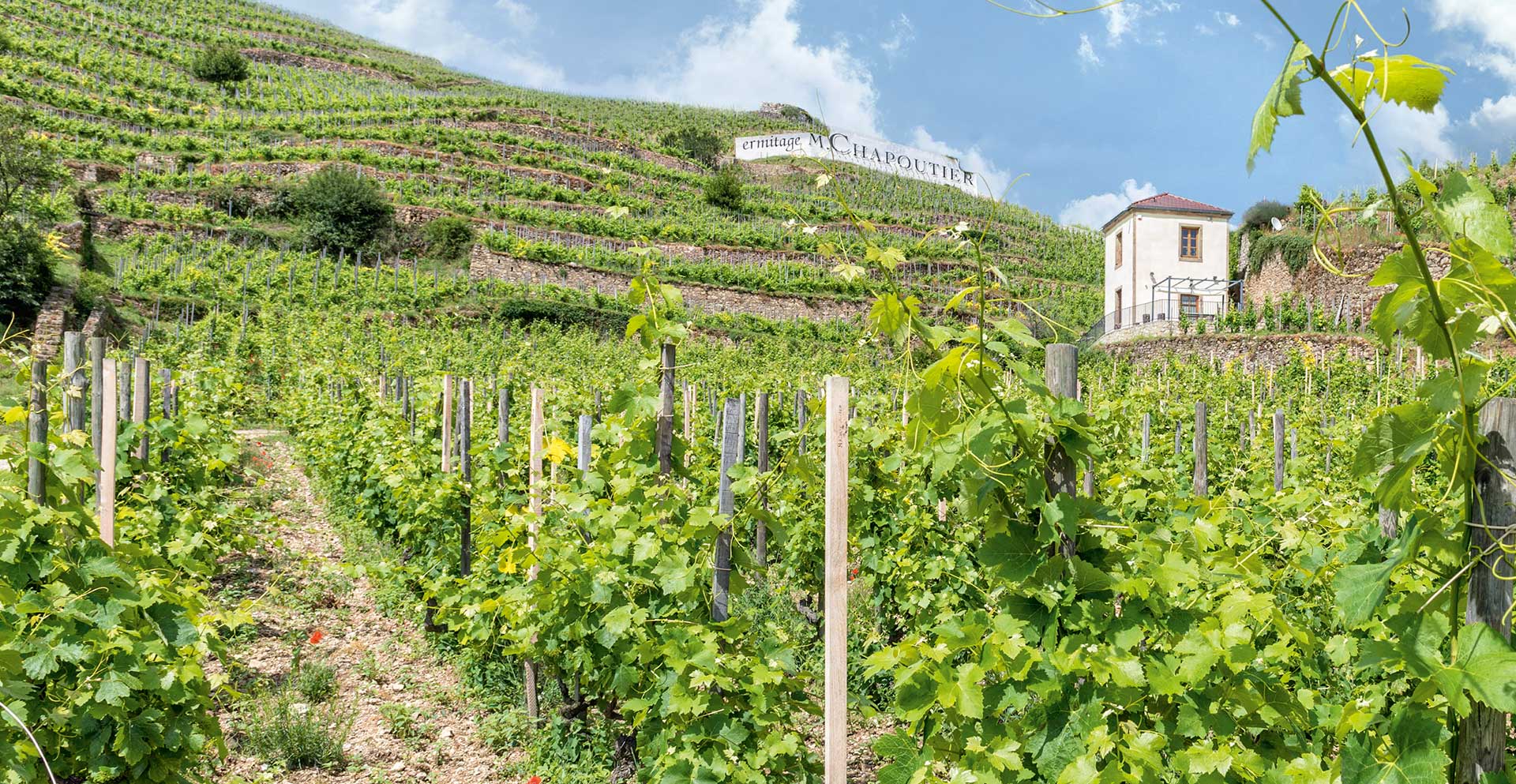Harvest 2019 in the Rhone Valley : an exceptional vintage
In the vineyard
10 March 2020
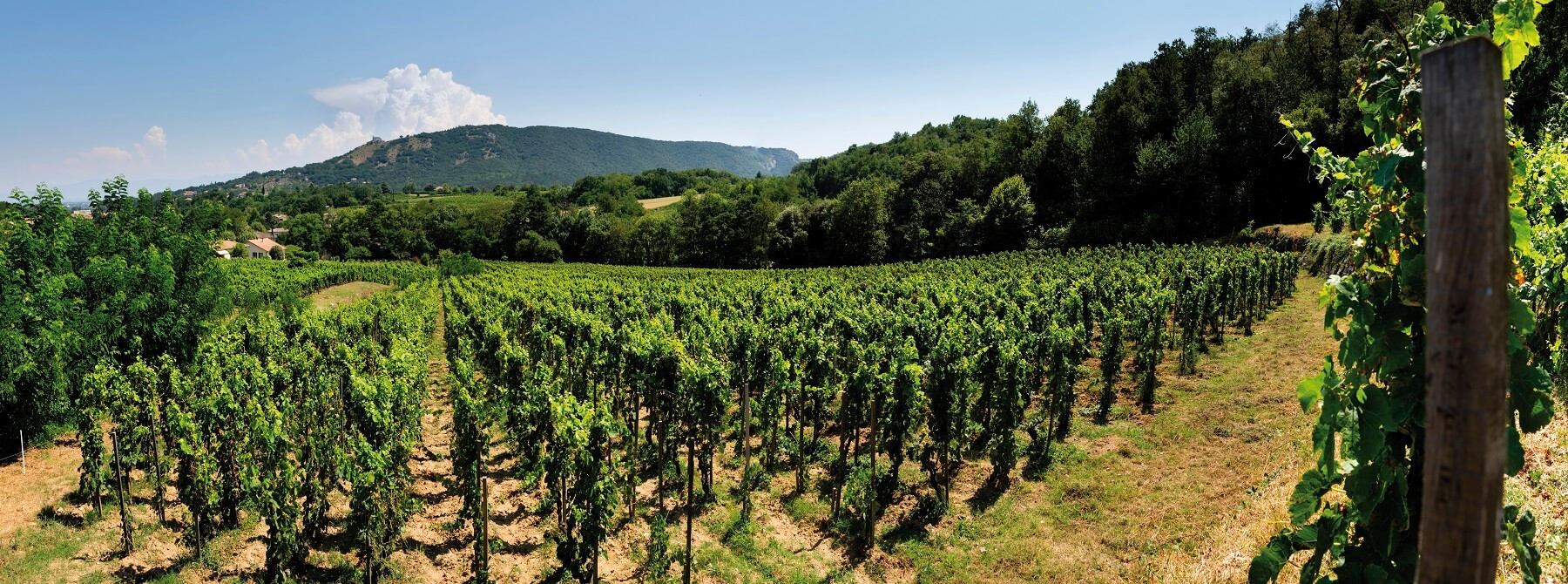
Whilst the hill enters its final phase, adorning its golden shroud of vegetation and illuminating these early days of autumn, it is with some trepidation that we Taste the year’s produce after a series of climatic extremes. Fine, elegant reds with refined tannins somehow manage to dispel the season periods of excessive heat. Perfectly balanced whites sublimed by minerality, preserved from the worst of the solar effect by early picking. Nothing could have presaged such potential after a season marked by weather that has been so difficult to predict as it swung from one extreme to another. When all is said and done, perhaps the winemaker’s art has done it all…
A cold, dry winter
After pruning on the Châssis sector vines (Crozes-Hermitage) in January 2019, re-building our vines in this area will take place in 2020 for other reasons entirely.
The tendrils are now ground up to be used later for composting and stem protection. Last year’s exceptionally rapid growth has left its mark on the tendrils, with longer-than-usual pruned lengths.
It is cold and dry during these first months of the year and rain is exceptionally rare, but water reserves built up over the autumn, with more than 400mm accumulated on average between October and December 2018. The plots at the foot of the Hermitage hill are pruned last in order to guard against all the threat of a spring frost. And yet daytime temperatures trigger the first leakage from the vine and drops of sap are already falling from the vines’ wounds in March.
Budburst is happening fairly evenly throughout the northern and southern parts of the Rhône Valley and at the end of March we start to see the first leaves coming out of their cottony cocoon to give life to this 2019 vintage. Budburst is tardier than last year (10 days later). The planting of this year are also starting up, in particular with the so-called Saint-Joseph hill entering a new stage on the Crozes-Hermitage plains and in Saint-Péray. This relatively cold start to the season is marked by rare rainfall during the winter (barely 60mm in the south of the Rhône Valley and 100mm in the north).
We will have to wait a few days longer to see whether the first Châteauneuf-du-Pape leaves pop out, whilst the natural grasses push through, painting a bucolic landscape in the middle of the stony ground. On Montfrin (Saint-Étienne domaine), we already have five leaves spread out and on Valliguières (Roc Folassière domaine), the first buds are just beginning to appear.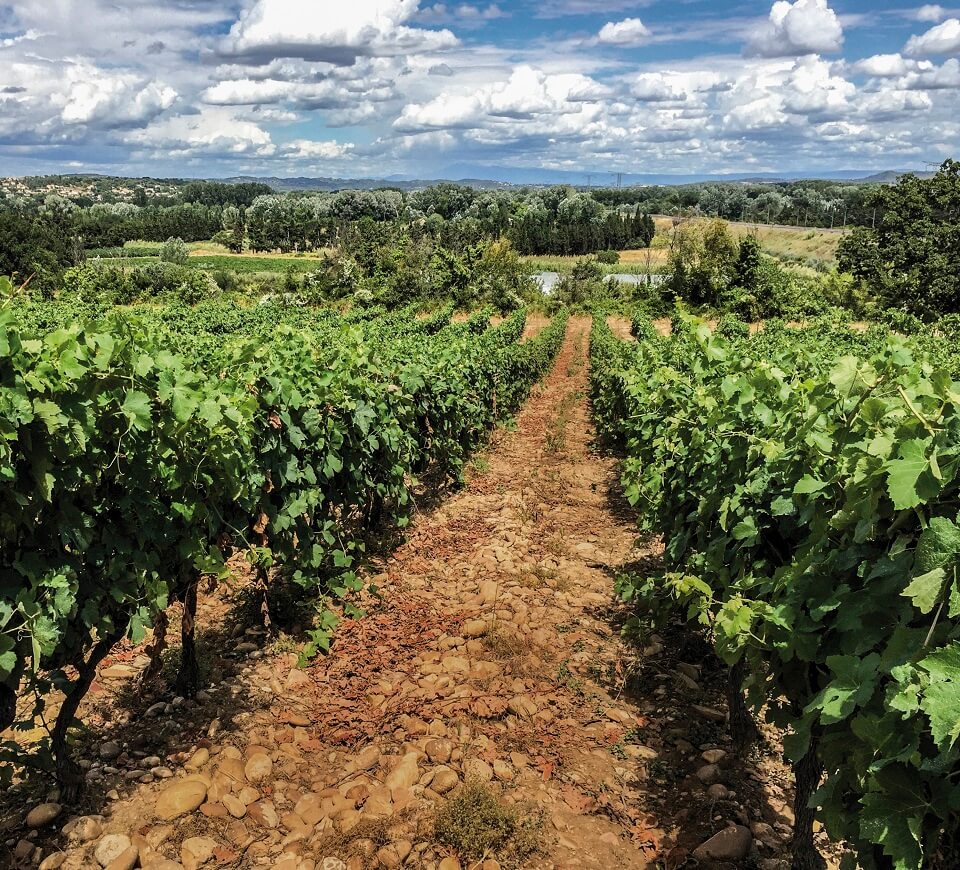
Jumpers in April
In the first week of April, a frost warning is announced… So we send out our teams to assess the risk and trigger the ‘frost protection’ procedure. We have been used to managing this climatic phenomenon since 2017. On April 5th, we fly over the hills to ward off the spring frosts. Nevertheless, in Chasses sur Rhône (Paul Lucidi & Michel Chapoutier), at the foot of the hill, damage from the frost is observed, but with no great consequences. The proximity of the towns around Vienne could do nothing to keep the temperature up: -2°C was recorded, and around 0°C in Tain.
After some much-awaited heavy rain, spring temperateness finally arrives and starts warming up the atmosphere. Flower heads start to emerge and the hill gradually turns green. The south-facing Méal already has a head start and branches are up to 20cm long with some strong leaf growth that adds a green sparkle. The first poppies redden the ground, and not before time.
The storm
On April 26th, we inspect damage to the vines after a storm struck the hill. An extremely violent southerly wind bucked and swayed the still-tender young tendrils.
The top sections of Méal and Grand Bessard (Pavillon) have been ravaged and leaves torn. It will take several days for the vine to return to growth. This windy episode combined with a coolish spring will leave their mark on certain plots throughout the period up to harvesting where leaves will not grow as usual, and some vines are stunted and discreet. In spite of that, bunches start to form and spread.
Storm in the air
From May 2019 onwards, the south and north of the Rhône Valley show divergent trends, but the salient, common factor is the lack of rain… Already on May 2nd, a first storm arrives and a number of melted hailstones fall on us as we explore the ground and vegetation of our Crozes- Hermitage plots on the remotest edges of Hermitage (Varogne, Mortier & Chauds). The first balloons go up into the sky and torches shimmer as the wind takes a hold. We look on, wondering whether this will be enough.
In the south, grape formation on the Grenache is exceptionally promising, but since blossom has not yet happened, we remain cautious, since we cannot be sure we will not see heavy leakage, remembering 2017 and 2018 and their meagre harvests…
The vines planted in 2019 are practically complete and the first green work including disbudding can begin with the greatest care. It will be generally pretty limited given delays to vegetation growth, the wind and what was to come next…
In Mirabel, the Viogniers don’t seem yet to understand that they will be short of water later on as we start applying the first compost concoctions, which are sure to be really useful during the summer.
On May 22nd, the first flowers start to blossom on Châteauneuf-du- Pape… Everything looks to be going well and leakage seems to be easily contained. A natural clearing which is beneficial for phenolic maturity, of which we’ll speak later.
On the Valliguières limestone… Roussannes – still pale at this stage – do manage to resist the lack of rain which, as one day turns to another, reminds us that there’s still a long way to go until harvest.
And on Montfrin, even though it is further south and exposed to the sun, the first flowers are only just coming out. Now that the first fastening operations are complete the blossom should not be too long coming on Hermitage. On the Crozes-Hermitage Syrahs, we observe once again the grape bunches start to sprout and spin.
The cold spring sees the grape aborting, naturally affecting production potential.
At the end of May, the Condrieu vines are still growing very slowly in spite of the 150mm of rain cumulatively over April and May. The first fastening operations are long over, and the vines are having difficulty getting out of this cool spring and overcoming the stormy winds. Like with Neve (Côte Rôtie), the windy episodes have had a real impact on the vines, but they are managing to recover in spite of everything.
At the beginning of June, the Pilate Viogniers come out in fine fettle from their latent vegetative state further to the recent rain and steadily rising temperatures. The vine now enters strong vegetative growth.
At this stage, in the whole of the Rhône Valley, the cryptogrammic pressure is no longer there… since there is little rain, with a few exceptions, the whole season will be extraordinarily calm.
On June 5th, the vine pollen perfume is heady and blossom at its peak. And the first flower heads are already sprouting from inflorescence.
The first grapes are starting to form on Méal which, in spite of the summery weather for this latter part of the spring, remain incredibly green. On Valliguières where the harvest is looking promising, the perfume of the vine pollen mixes with aromatic thyme and broom scents to beautify the garrigue landscape, but the absence of rain is starting to be a worry.
Fruit set is beginning on certain plots whilst others are finishing the blossoming phase. The weather is fine and hot, with not a drop of rain on the horizon.
The symptoms of hydric stress are not yet apparent whereas for the 2 coming months there will be no rain on the Mirabel sector. The deep clay ground will, along with the plant concoctions, get us to the end of this dry, dry year.
Healing
On Saturday June 15th, at around 1pm, dark masses start to gather in the sky… At around 2pm, the first hail starts to hammer roofs. We go out to see what is going on. Driving rain mixes with hail, initially the size of peas, but soon turns into the size of golf balls. So, we go around Hermitage and to our enormous surprise there is no damage… The disaster is however unfolding on the Crozes. A band of hail slaps the earth and its footprint can be clearly seen once it has passed by and gone to burn itself out in Romans sur Isère. We are lost for words in face of the devastation to the vines. A few days later, whilst the impacts start to dry and heal, we have a better understanding of the devastation, which will carry over into the next season such is the scale of the damage. Only 5 hectares of the domain are severely affected… and others to a lesser extent. The valerian herbal concoctions are applied to help the vine. But the trauma is definitely there. We decide to leave the vine alone for the rest of the season to allow it to re-build little by little.
The rain came after all.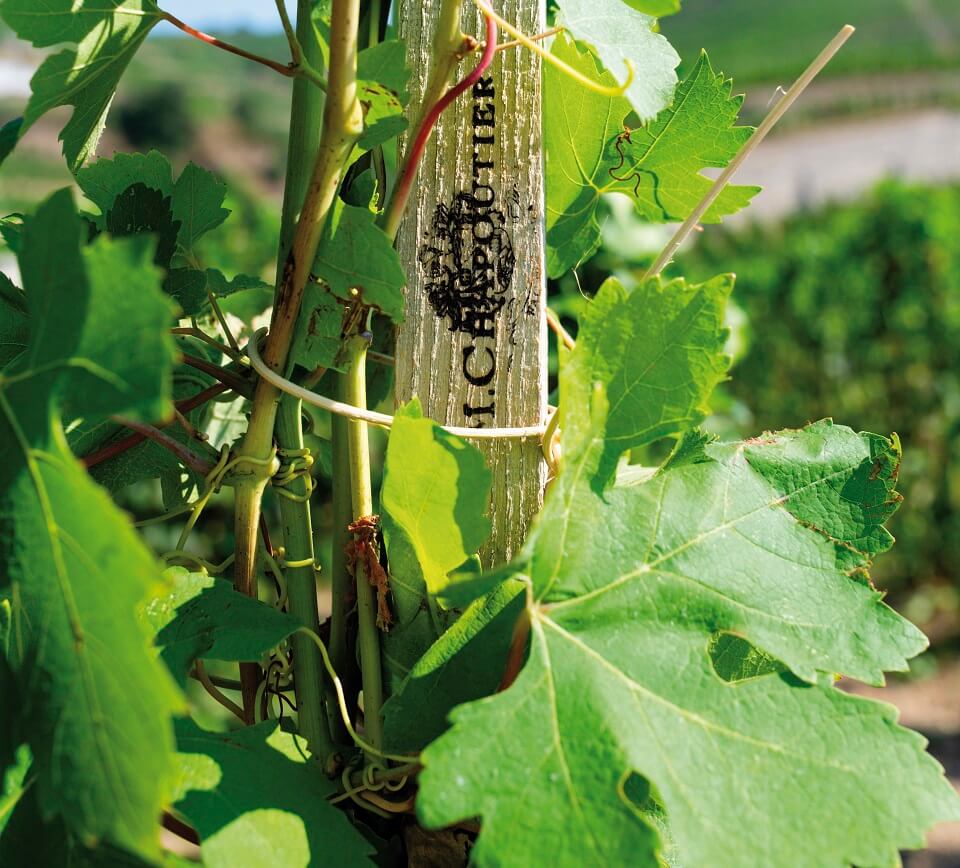
Summer fires
Whilst the heat is omnipresent, we adapt our growing practices to use the Roussillon methods so as to avoid the effects of the heatwaves. Leaf pruning stops to leave the grapes in the shade. Dead-heading is stopped too to provide natural shade to accompany the treatment… it’s so hot. We feel we can adjust all this at a later date if necessary. But the weather vane is pointing towards a heatwave… At 10am, we already have temperatures above 35°C.
A heatwave is announced for this week with temperatures as high as 44°C in the south!
Friday 28th June is the turning point in the south of the Rhône Valley.
A fire breaks out in Montfrin, which encircles the village and looks threatening, stoked by a Mistral wind that has not been felt until now. The fire burns throughout the weekend before being brought under control, but 1.5 hectares of vines are swallowed up by the fire and perish in its flames.
Having almost forgotten the heatwave, Monday morning comes around, and the damage caused by the ‘summer fire’ becomes visible.
A burning wind had blown over the vines. The leaves were literally fried as were all the grapes which now look like dangling raisins. We have never seen this before… Whilst the damage is greater in the south of the Rhône Valley, a few traces of the heatwave are also visible in the north around the grapes unsheltered by leaves. The few budding grapes there are burned… to the extent that later the pips continue to grow in the dry cuticle and burst open the grapes. Only the herbal concoctions will be applied in the evening to temper the fire’s work.
Some domaines are spared the burning wind, like the Valliguières, protected by its relatively high altitude and limestone ground, which is better at absorbing the heat… Mirabel and the Châteauneuf-du-Pape Grenaches, trained in rounded-vase shape, will also be spared by the natural protection offered by their trailing growth. This heatwave episode arriving so early in the summer season was to have no other impact than lesser harvests, and therefore no effect on the maturation of grapes later in the season.
As amazing at it seems, the vines which were so badly damaged by the hail mid-June have grown back well and are starting to come into leaf again… For the harvest there is nothing more to hope for. And suddenly a new storm builds in the night and shakes the plants… Alarm signals turn from amber to red, and the heavy guns blast through the sky in the early hours of July 7th, and a few impacts are felt on the Pilate and Gervans (Yannick Alléno & Michel Chapoutier) but they suffer only limited damage. The leaves left to protect the grape from the heatwave took the sting out of the small hailstones which slipped off them. Whilst the brutal rains bring water to the north, in the south we have lost all hope of seeing any… None is forecast at any rate.
The green work on the vines can re-start, but with great care, as we are now at the end of July and the heat is expected to persist…
On July 18th, we see the first vines turning green on the Greffieux and Cornas sectors. Finally, in spite of all the delays, the vines make up for lost time and continue their growth notwithstanding these repeated extreme weather episodes. The young vines that do not yet have very deep roots start to suffer and symptoms of defoliation emerge.
And yet…
In the middle of August, we start some leaf trimming to aerate the grapes now that the peaks of the heatwave are over, in order to accelerate maturation. Whilst the vintage was expected to emerge a little late, maturation accelerates fairly spectacularly with the return of what can be considered a heatwave for that period. Marsanne turns fully golden in the late August sunshine…
In spite of this, some grey mould is visible in the Ampuis sector, after a cumulative 150mm of rain during August. Decidedly, it’s not over yet. So, we force the pace to free up the grapes that we sought to protect throughout the summer in order to prepare for harvest. The acidity levels on the Marsanne are astonishingly high according to the first maturity controls – undoubtedly due to the leafy protection that prevented them burning. And it is for this reason we decide to start harvesting fairly early to harness all this potential. On September 2nd 2019, once again on the Méal, our staff get together to start the second descent of the Hermitage hills. Finally, not so late as all that, but not so early either.
We were to make the most of this beautiful first week of September to pick the whites primarily, thus preserving their acidity, given the summer temperatures forecast for the days ahead.
On September 4th we gather the Vin de Paille at daybreak. We have not made any of it into wine for 10 years. And so with the greatest care and all the necessary precautions, staff meticulously lay the Marsanne grapes on the crates in preparation for 45 days’ drying to gain in concentration before pressing on October 22nd. At the same time, we start the harvest on the Saint-Étienne domaine with the Abelhas, Roussannes having evolved well, plus the Costières de Nîmes (Capréa). Harvesting then continues its course for the reds and finishes up with the old plots of Grenache, including La Garrigue where the exceptionally lavish fruit announces a fine vintage.
The first Saint-Péray will not take much longer for the Muse de RW... Whilst in Mirabel everything has gathered pace with the heat, the viognier will be picked during the weekend of September 7th… The grapes have remained small with the lack of summer water but the beneficial effects of the compost, the herbal concoctions and the wine-grower’s art will produce a very balanced wine. On Ampuis and Condrieu, the grapes are starting to evolve well and it is now certain that we won’t be harvesting in October like 15 years ago… global warming. The chef, Yannick Alléno, will come to monitor the development of grapes on the Chabot and Guer Van, as he prepares for the opening of his new brasserie. And then a moment of calm marked by some sunset wine tasting at the Tour Carrée of Chante-Alouette.
The return of summer heat is announced for September 12th onwards when temperatures will be approaching 30°C through to September 17th, which will speed up the maturation of the reds. Meanwhile, staff are in action picking the grapes to prevent the solar effect cancelling out the minerality of the wines we are looking for, which is why we will be picking the red on the Lieu-dit Saint-Joseph hill on September 6th and the Méal red from September 9th. The Viogniers de Esteban on the Combe Pilate domaine will be picked on September 9th where acidities suggest a fantastic sparkling wine for laying down.
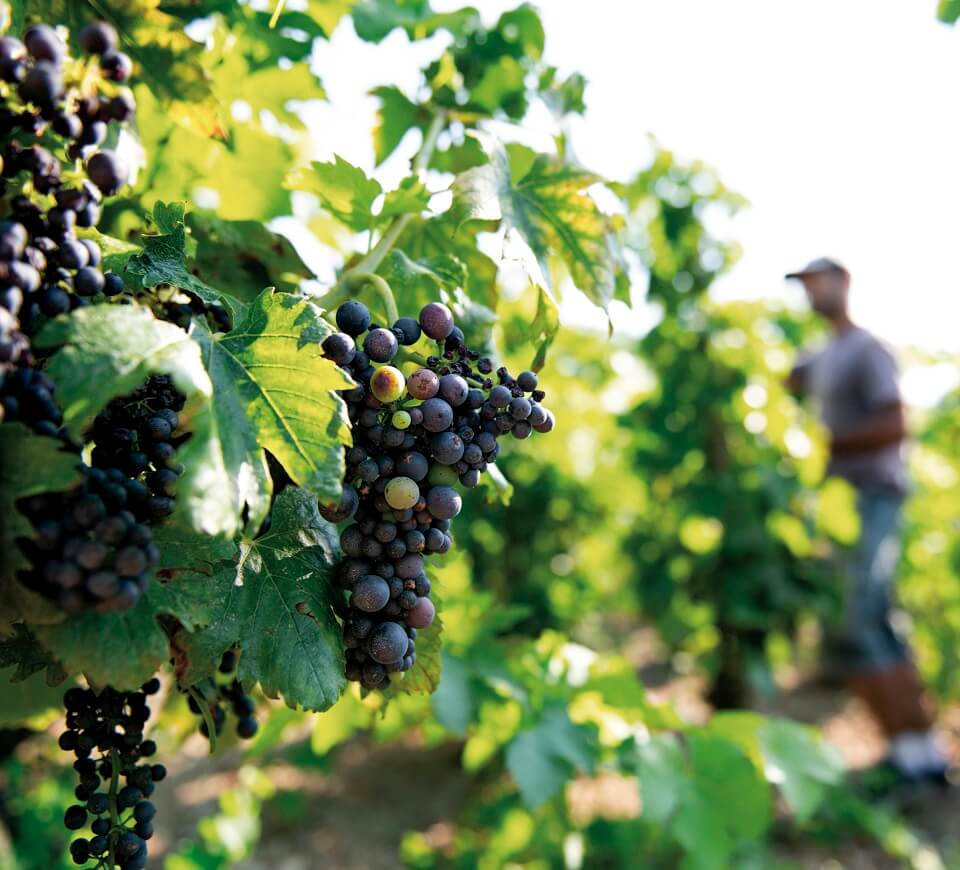
Meanwhile, in Valliguières harvesting is just beginning. The year is characterised by modest-sized grapes because of the lack of rain, but high acidity concentrations presaging a fine elegant vintage dominated by fruit. It promises a balanced vintage, meaning the first batches can be processed without sulphites.
Back to Saint-Joseph and the granitey ground of Tournon-sur-Rhône to pick Le Clos on September 10th. And there, everything speeds up with the onset of hotter temperatures during the day and very cool nights.
We go on to pick the Pilate Viogniers and then the white Hermitages at Chante-Alouette. On Châteauneuf-du-Pape, on September 11th some promising and much-awaited harvesting begins starting with the syrahs before waiting a few days to start on Grenaches. The Ermite white, protected from the heat on the upper reaches of the hill, have matured unfettered and arrive at perfect maturity for picking on September 12th, as soon as the first rays of sun start to shimmer on the Marsanne fruit. At the same time, another picking crew heads to Condrieu and to the Chery hills to work on Viogniers.
Once again, the teams are called upon to play a crucial role in completing some fine grape picking in record time, in preparation for a vintage which will be little impacted by the solar effect thanks to their speed.
And then in quick succession, harvesting of Greffieux on September 16th and Pavillon on September 17th.
Also on September 17th we go to Côte Rôtie to get the Neve and the next day the Mordorée.
First Grenaches on Châteauneuf-du-Pape come into the cellar on September 18th. On September 22nd all the Hermitage planes are harvested during Vendanges du Cœur day.
Anne-Sophie Pic’s wine experts come to help us out to harvest the Lieu- dit Payrolles (Anne-Sophie Pic & Michel Chapoutier) on September 19th, where the Marsanne on the granite ground announces an exceptionally mineral vintage with freshness and tension in the grapes.
Whilst the rain is forecast on Châteauneuf-du-Pape, we take the decision to pick Croix de Bois on September 20th so as to avoid any alteration to the grenache fruit, so promising is this vintage.
Wager won!
Already, the end of grape picking is nigh and the last Ermite reds come into the cellar on September 20th.
The Guer Van is harvested on September 23rd in the end, meaning that we get to finish the whole race against excesses of heat on September 30th with the Chabot in the northern Rhône Valley and the Châteauneuf- du-Pape with Barbe Rac on the 1st October in the south of Rhône Valley. Whilst in the cellar the work on the tanks has been adapted so as not to extract too much to maintain the balance of the wines and preserve the velvety tannins of the reds, we taste an extraordinary vintage marked by
sometimes violent, sometimes extreme, weather conditions, which in the end contributed to creating a vintage which was actually protected from all these excesses that came so early in the season, with the help of the wine-grower’s craft and decision to pick quickly and early: as if in the end, it all hinged on the art and planning of the wine-grower…


